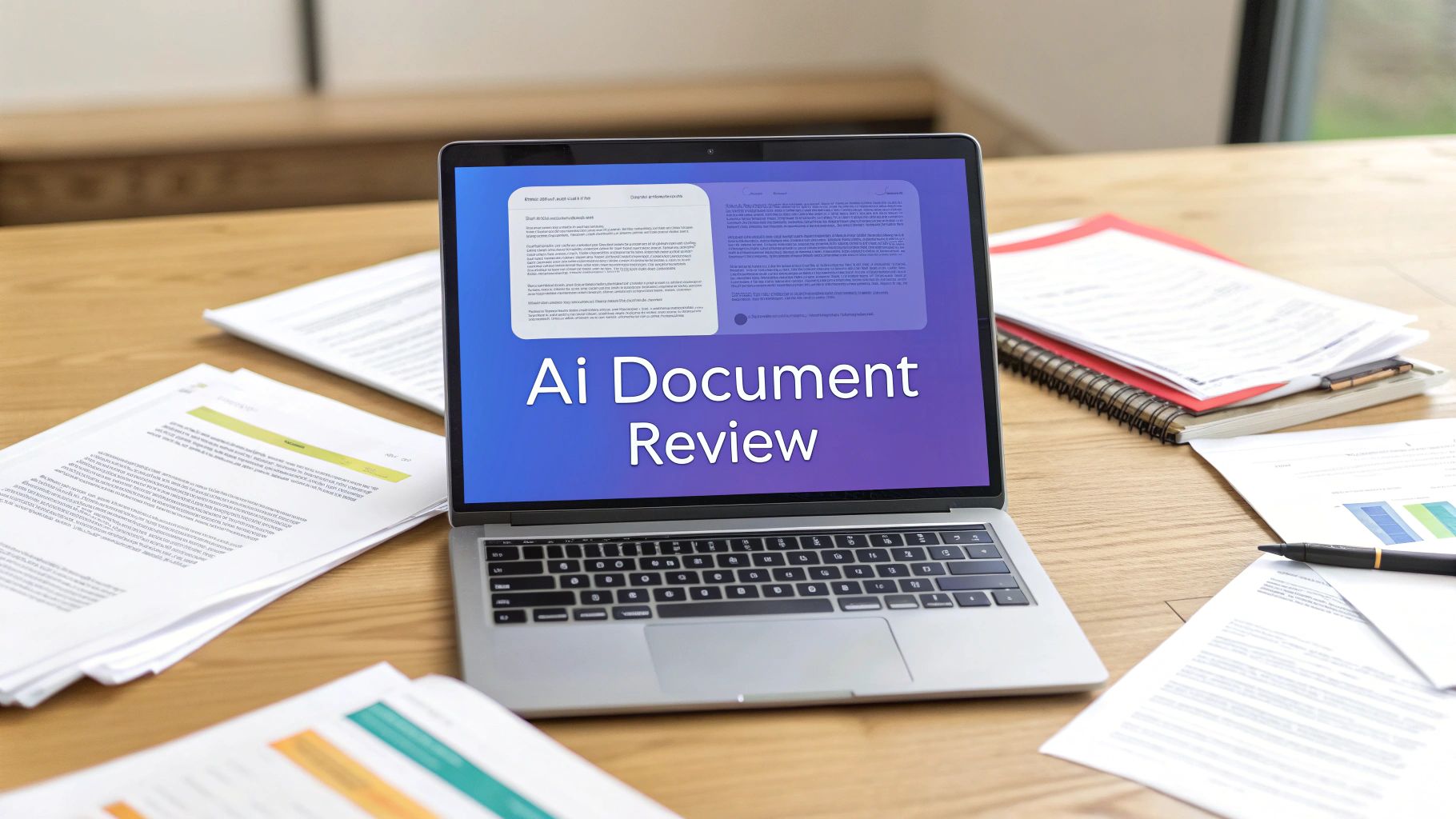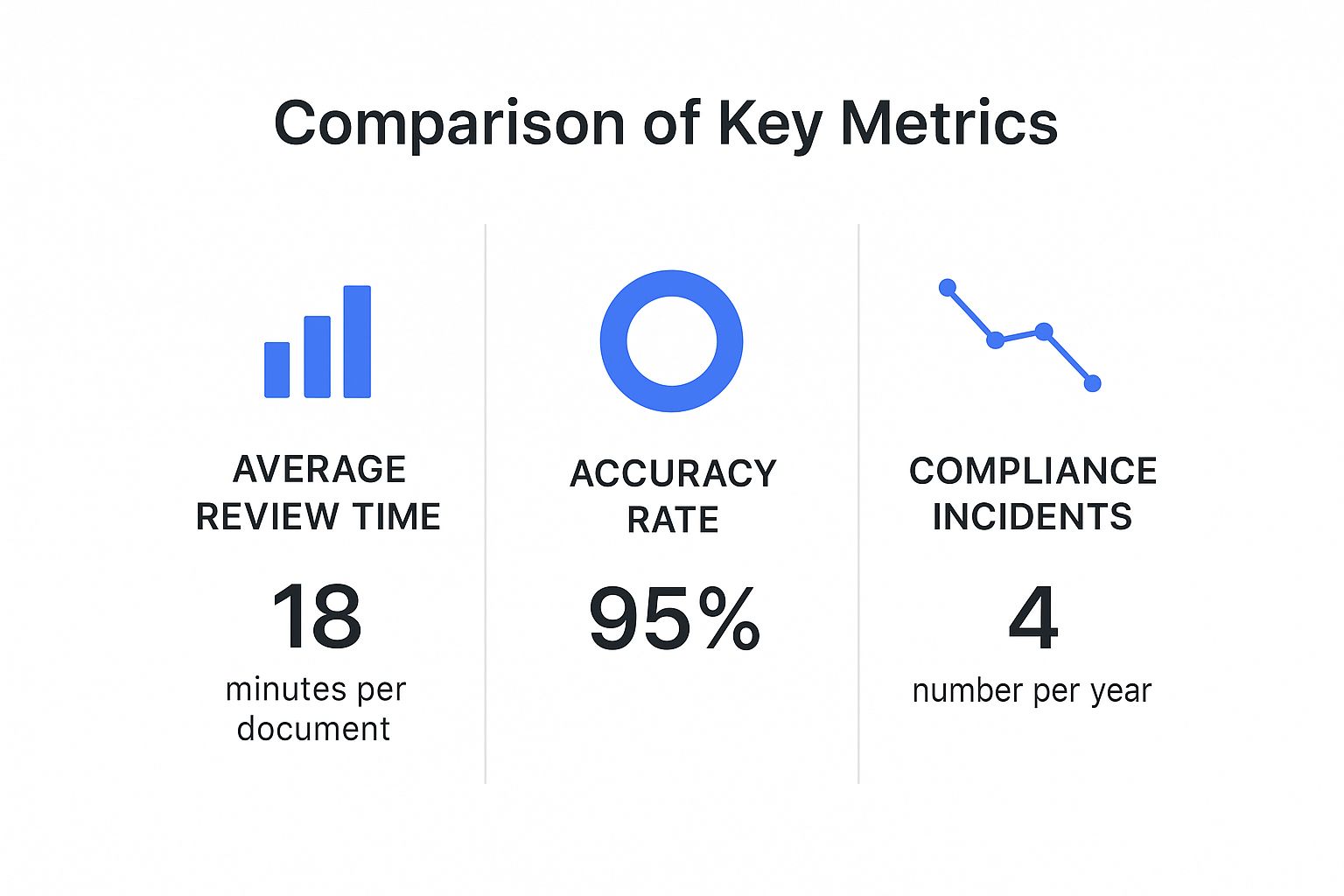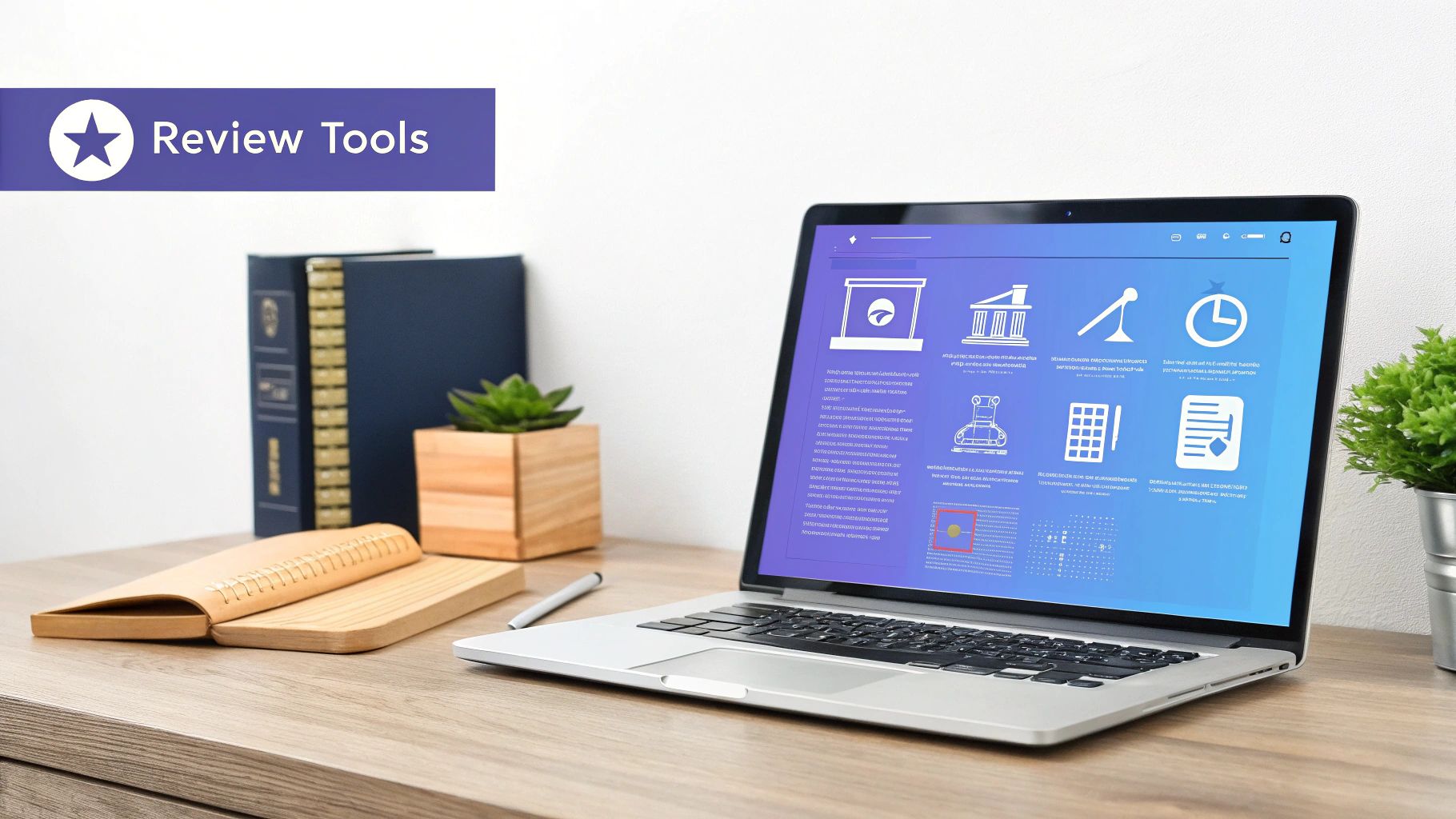
Forget the old-school image of lawyers drowning in stacks of paper. Today, legal document review is all about a smart mix of human expertise and AI-powered tools. It’s no longer just about catching typos—it’s a strategic process for navigating the massive flow of digital information, from everyday contracts to the mountains of data in complex litigation. The real goal is to sniff out risks, spot opportunities, and make decisions backed by solid data.
The Shift in Modern Legal Document Review

Legal document review has evolved far beyond a simple proofreading exercise. It's now a critical business function focused on managing huge volumes of information with both speed and precision. We’ve moved past just finding mistakes; the new game is about strategically analyzing information to get a leg up. This change was inevitable, really. The sheer volume and variety of data we deal with today make the old manual methods impractical and, frankly, impossible to scale.
To handle this new reality, legal teams are embracing a tech-forward workflow. It’s not about replacing people, but about augmenting their skills. To give you a clearer picture, here’s a breakdown of the core stages in a modern, tech-assisted document review process.
Core Stages of Modern Document Review
This table outlines how technology integrates into each stage of the review workflow, leading to more accurate and reliable outcomes.
| Stage | Objective | Key Activities |
|---|---|---|
| Initial Assessment | Define the scope and goals of the review. | Identify key documents, establish parameters for relevance, and set up the review team. |
| Data Processing | Convert various files into a unified, searchable format. | Digitize paper records, extract text from images (OCR), and organize all data centrally. |
| AI-Assisted Analysis | Rapidly categorize and analyze the document set. | Use AI tools to flag keywords, identify clauses, summarize content, and tag documents for relevance. |
| Human Review | Apply expert judgment to AI-flagged documents. | Scrutinize high-risk items, interpret nuanced language, and make final determinations on critical issues. |
| Reporting & Action | Synthesize findings into actionable insights. | Create summaries, build case timelines, and present a clear report for decision-making. |
As you can see, AI handles the heavy lifting, allowing human experts to focus their energy on the high-value tasks that require critical thinking and experience.
The Driving Force Behind This Change
Artificial intelligence is what makes all of this possible. AI has fundamentally changed the game by automating tasks that used to be incredibly time-consuming. As of early 2025, AI tools powered by machine learning and natural language processing are helping lawyers tear through massive legal databases with impressive accuracy and speed.
Platforms like Clio Duo and Logikcull are great examples of this in action. They can process incredibly complex legal data to pull out relevant insights that would take a human reviewer ages to find. You can learn more about how AI enhances legal document review and its growing impact on the industry.
This isn't about replacing lawyers; it’s about empowering them. The true value lies in freeing up legal experts to focus on what they do best: strategic thinking, negotiation, and providing counsel based on the best possible information.
Ultimately, this modern approach helps legal teams and businesses tackle vast amounts of information with more confidence. By blending sophisticated tools with seasoned human expertise, the review process transforms from a reactive chore into a proactive tool for managing risk and finding opportunities.
Setting Up Your Documents for AI Analysis

Here's a hard-earned lesson: a great AI-powered review starts long before you ever click "analyze." The time you spend prepping your documents directly impacts the quality of the insights you get back.
Think of it like organizing your kitchen before tackling a complex recipe. If your ingredients are all over the place, you’re setting yourself up for a messy, disappointing meal. It's the same with legal documents.
Your first move is to pull everything relevant into one place. This isn’t just about the main contract. It’s all the amendments, exhibits, schedules, and even the email chains where terms were hammered out. If you're looking at a vendor agreement, you also need the initial proposal and all the back-and-forth that followed. An AI can't connect dots it doesn't have.
Creating a Clean and Searchable Dataset
With everything gathered, the next job is to make sure it's all in a clean, digital, and—most importantly—searchable format. AI tools can't do much with blurry scans or locked image files. This often means running Optical Character Recognition (OCR) on any scanned PDFs to turn pictures of text into actual text the AI can read and process.
I've seen this go wrong in the real world. A company was deep in due diligence for an acquisition, and the target company handed over a digital folder stuffed with:
- Signed contracts saved as scanned JPEGs.
- Financial statements in non-searchable PDFs.
- Key negotiation points buried in a 50-message email chain.
Feeding that disorganized mess to an AI would have been a waste of time, producing fragmented and unreliable results. The only way forward was to standardize everything first. Convert the JPEGs to searchable PDFs, export the entire email thread into one chronological document, and get it all organized. This creates a clean timeline the AI can actually work with to spot inconsistencies or hidden risks.
The single biggest pitfall in AI-driven review is poor data preparation. Garbage in, garbage out. Success hinges on a clean, organized, and properly contextualized set of documents.
Defining the Scope of Your Review
Finally, you need to tell the AI what you're looking for. A clear, defined scope is non-negotiable. Before you kick off the analysis, ask yourself what you actually need to find.
Are you hunting for specific termination clauses? Mapping out all financial obligations? Or trying to flag instances of non-compliance? Setting these parameters upfront focuses the AI's "attention," so it doesn't waste processing power on irrelevant fluff.
For example, when using a tool like the Legal Document Simplifier, you can guide its analysis toward identifying specific risks, deadlines, or liabilities. This simple step transforms a broad data dump into a targeted, efficient, and far more accurate review. A little foundational work here prevents scope creep and ensures your analysis is sharp from the get-go.
Handling Modern Electronically Stored Information
The days of poring over neat stacks of printed pages are long gone. The very definition of a "document" has exploded, and any modern legal review has to grapple with this new reality. The real challenge today isn't just volume; it's analyzing a sprawling universe of electronically stored information (ESI) that goes far beyond traditional files.
We're talking about everything from Slack direct messages and Microsoft Teams channels to WhatsApp voice notes and even the emojis used in a conversation. Each piece of this fragmented communication puzzle can hold critical evidence, but only if you know how to find it. This is where old-school review methods simply fall apart.
Beyond Simple Keyword Searches
Running a standard keyword search on a chat log is like trying to understand a movie by only reading a list of words from the script—you lose all the crucial context, timing, and subtext. Who said what? When? What was the reaction? A simple search can't answer these questions.
The sheer complexity of modern ESI is one of the biggest hurdles in legal document review today. You need specialized techniques to handle fleeting data like chat messages, voice notes, and emoji reactions to preserve the story they tell.
This is why specialized tools and techniques are now essential. Instead of just pulling up a list of keywords, a proper ESI review involves:
- Timeline Analysis: Rebuilding conversations chronologically to see the flow of events as they actually happened.
- Near-Native Views: Looking at data in a format that mimics its original platform, complete with usernames, timestamps, and reactions.
- Relationship Mapping: Figuring out who was talking to whom and how often to uncover key players and communication patterns.
A single thumbs-up emoji on a problematic message can completely change its legal meaning. This is the level of detail modern review must capture. Context is everything, and failing to preserve it is a critical mistake.
Practical Strategies for Modern ESI
Imagine you're reviewing a project's communications from a Slack channel. A simple text dump of the messages would be a jumbled mess. A far better approach is to export the entire channel—threads, replies, and reactions included—into a platform that can display it chronologically. This lets you see if a critical instruction was acknowledged, ignored, or even ridiculed.
Effectively managing these new data types is a core part of modern legal document management. For instance, an AI tool can transcribe a series of voice notes and slot them directly into the text-based conversation timeline. This creates a complete, unified record of what was communicated.
This is how you find the signal in the overwhelming noise of modern data—with a defensible, methodical approach that ensures your review isn't just thorough, but a true reflection of what actually happened.
A Strategic Framework for Finding Critical Clauses
Once you’re prepped, the real analytical work begins. This isn't about passively reading a document from start to finish. It's about putting on your detective hat and strategically hunting for what truly matters—the hidden liabilities, ticking-clock deadlines, and vague obligations that can sink an agreement.
I’ve seen too many costly legal issues pop up from "silent killer" clauses that seem harmless on the surface. Think of an automatic renewal clause in a vendor agreement that locks you into another year at a bad rate unless you give 90 days notice. Or a vaguely worded indemnification clause that suddenly makes you responsible for a partner’s screw-up. A strategic review is designed to find these landmines before they go off.
Prioritizing High-Risk Areas
Not all legal documents carry the same weight. A simple Non-Disclosure Agreement (NDA) has a totally different risk profile than a multi-million dollar Merger & Acquisition (M&A) file. So before you even start reading, you need to categorize the document to focus your energy.
Just ask yourself: what’s the worst that could go wrong here?
If you’re signing up for new software, the hot spots are probably:
- Data Security: What’s their plan for protecting your data, and what happens if there’s a breach?
- Limitation of Liability: What's the most the vendor will pay out if their service fails and causes you damages?
- Termination Rights: How hard is it to ditch the service if it doesn’t live up to the sales pitch?
This risk-first approach helps you cut through the noise and zero in on the clauses that matter most. It makes your review faster and far more effective.
The image below shows just how much a structured, AI-assisted review can outperform a purely manual one.

As you can see, bringing AI into the mix doesn't just shave off review time; it boosts accuracy and cuts down on compliance headaches.
High-Risk Clause Watchlist
Some clauses are notorious for hiding risk. It's a good idea to have a mental watchlist for these common troublemakers so you can give them extra scrutiny when they appear.
| Clause Type | What It Governs | Red Flags to Watch For |
|---|---|---|
| Indemnification | Who pays for legal damages if a third party sues. | Overly broad language (e.g., "any and all claims"), no cap on liability, one-sided obligations. |
| Limitation of Liability | The maximum financial responsibility one party has. | A cap that's too low (e.g., just one month's fees), excluding gross negligence or willful misconduct. |
| Automatic Renewal | Whether the contract renews without your consent. | Short notice periods for cancellation (e.g., less than 60 days), lack of a clear end date. |
| Termination for Convenience | The right to end the contract without a specific reason. | One party having this right while the other doesn't, high termination fees. |
| Governing Law/Jurisdiction | Which state's laws apply and where disputes will be heard. | An inconvenient or unfamiliar jurisdiction that would make litigation expensive and difficult. |
This isn't an exhaustive list, but keeping an eye out for these specific clauses will help you spot a huge chunk of potential problems right away.
Building a Flexible Clause Checklist
Rigid templates can be a pain, but a flexible checklist tailored to your needs is a game-changer. This isn’t just a list of clause titles to check off; it’s a set of prompts to make you think critically. For a more detailed breakdown, our guide on the contract review process goes into much greater depth.
The goal isn’t just to find clauses, but to understand their practical effect. A "force majeure" clause might seem standard, but its definition could exclude events like a supply chain disruption, leaving you exposed.
Instead of just going in page order, organize your checklist by risk categories. This forces you to think thematically about your protections and obligations.
Example Checklist Categories:
- Financial Obligations: Payment terms, fees, interest on late payments, expense reimbursement.
- Performance & Timelines: Key milestones, delivery dates, reporting requirements, acceptance criteria.
- Risk & Liability: Indemnification, limitation of liability, insurance requirements, confidentiality.
- Term & Termination: Contract length, renewal terms (auto-renewal vs. mutual consent), termination for cause, termination for convenience.
Using a framework like this transforms you from a passive reader into a proactive analyst. You're now armed with a system for spotting trouble before it has a chance to start.
How AI Is Transforming Document Review

It’s impossible to talk about modern legal document review without bringing up artificial intelligence. But let's get past the buzzwords and look at how these tools actually work in the real world. AI isn't some futuristic concept anymore; it's a practical tool that's fundamentally changing how legal analysis gets done.
At its heart, AI gives legal pros a massive analytical edge. These platforms can chew through thousands of pages in minutes, tackling tasks that would bury a human reviewer for weeks. This isn't just about doing things faster—it's about uncovering a deeper level of insight.
Imagine an AI platform that can instantly flag non-standard language in a contract by comparing it to a database of thousands of similar agreements. It can also distill dense, jargon-filled sections into plain English or spot conflicting terms scattered across a mountain of discovery documents.
Unlocking Efficiency in eDiscovery
Nowhere is this shift more obvious than in eDiscovery. Let's take a typical commercial litigation case. You’ve just been handed a data dump of 500,000 documents—a mix of emails, contracts, and internal memos.
For a small legal team, manually sifting through that pile to tag documents for relevance and privilege is a budget-draining, multi-week nightmare. But with an AI-powered platform, that same team can get more accurate results in just a few hours. The AI does the heavy lifting, sorting documents and flagging high-priority items for human eyes.
This process has become so effective it's reshaping the legal industry itself. In 2024, generative AI (GenAI) hit a major turning point in legal documents review, with studies proving it could outperform human teams in both speed and accuracy on large datasets. By 2025, this led many top firms to pull back from outsourced review services, bringing the work in-house with their own AI tools.
But this tech doesn't make legal experts obsolete. Quite the opposite. By automating the mind-numbing grunt work, AI frees up professionals to focus on what really matters: high-level strategy, deep-dive fact investigation, and building a winning case.
From Document Sorter to Strategic Partner
The real magic of AI in legal documents review is how it evolves from a simple sorting tool into a strategic partner. Today’s platforms do far more than just find keywords; they understand concepts, gauge sentiment, and map out relationships within the data.
An advanced AI can:
- Generate Instant Summaries: Turn a 50-page lease into a one-page brief, highlighting key obligations and deadlines.
- Spot Anomalies: Flag a clause in a new vendor contract that's way off from your company's standard terms.
- Create Timelines: Automatically pull dates and events from a long email chain to create a clear, chronological story of a negotiation.
This level of analysis gives you a serious competitive advantage. Instead of drowning in details, legal teams can work from a place of informed oversight. You can explore our complete guide on legal document review to see how this all fits into a broader strategy. Ultimately, it allows for smarter, faster decisions and better outcomes for clients.
Of course. Here is the rewritten section, designed to sound like it was written by an experienced human expert, following all your specified requirements and style examples.
Still Have Questions About AI in Legal Review?
As AI weaves its way into more professional fields, it's completely natural to be skeptical—especially when things like client confidentiality and legal accuracy are on the line. Let's tackle some of the most common questions and concerns that pop up when you're thinking about bringing AI into your legal review workflow.
Is AI Really Good Enough to Replace a Human Reviewer?
This is the big one, and the short answer is a hard no. AI is an incredibly powerful assistant, not a replacement for a seasoned legal pro.
Think of it this way: AI is your new, hyper-efficient paralegal who can read thousands of pages in minutes. It's built to handle immense volume and speed, accurately flagging the specific documents or clauses that need your attention. A good workflow uses AI to do the heavy lifting, allowing lawyers to spend their time on what truly matters—nuanced interpretation, strategic thinking, and client counseling. Those are things a machine just can't replicate.
The goal isn’t replacement; it’s augmentation. AI handles the scale, while humans provide the critical thinking and strategic oversight. That partnership is what leads to better, faster, and more cost-effective outcomes.
How Can You Guarantee Confidentiality When Using AI Tools?
Data security isn't just a feature; it's non-negotiable. Any reputable legal AI provider knows this and builds their platform with enterprise-grade security from the ground up.
When you're vetting a tool for your legal document review, you absolutely must confirm it includes:
- End-to-end encryption for all data, whether it's being uploaded or just sitting on a server.
- Secure, private cloud instances that keep your data completely isolated from other users.
- A rock-solid data policy that guarantees your client information is never used to train public AI models.
Before you even think about committing to a service, demand total clarity on their security setup and data policies. Your duty of confidentiality extends to the technology you use, so you have to be rigorous here.
What’s the Biggest Mistake Firms Make When Adopting AI?
The most common—and most costly—pitfall is simply a lack of preparation. Too many firms think they can just dump a chaotic folder of files into an AI platform and get magic back.
The reality is that the quality of the AI's output is tied directly to the quality of your input. If you skip the data prep phase—organizing files, digitizing physical documents, and making sure everything is in a searchable format—you're just setting yourself up for frustrating and inaccurate results. A successful AI-powered review starts with a clean, well-organized dataset.
Can AI Analyze More Than Just Text Files?
Yes, and this capability is quickly becoming essential. The definition of a "document" has exploded beyond simple text files. Modern eDiscovery and review platforms are now using sophisticated AI to process a whole range of media formats.
This includes things like:
- Transcribing audio from phone calls or video from depositions.
- Using object recognition to identify items or even text within images.
- Analyzing the sentiment and tone of voice in audio recordings.
This is critical for conducting a truly comprehensive legal documents review. It ensures no piece of evidence gets missed just because it wasn't in a traditional Word doc or PDF.
Ready to demystify complex legal language and streamline your review process? Legal Document Simplifier uses powerful AI to turn dense contracts, leases, and agreements into clear, actionable summaries. Upload your documents today and make faster, more confident decisions. Try Legal Document Simplifier now.